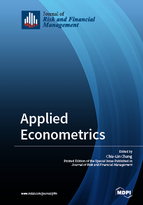Applied Econometrics
A special issue of Journal of Risk and Financial Management (ISSN 1911-8074). This special issue belongs to the section "Applied Economics and Finance".
Deadline for manuscript submissions: closed (31 December 2018) | Viewed by 83800
Special Issue Editor
Interests: applied econometrics; financial econometrics; energy finance; time series analysis; forecasting; empirical industrial organisation; risk management
Special Issues, Collections and Topics in MDPI journals
Special Issue Information
Dear Colleagues,
This Special Issue is concerned with the broad topic of Applied Econometrics, and includes any novel theoretical or empirical research associated with the application of econometrics.
Theoretical contributions should be associated with an empirical example, or directions in which the novel ideas might be applied.
The Special Issue may be associated with any contributions in: Theoretical and applied econometrics; economics; theoretical and applied financial econometrics; quantitative finance; risk; financial management; theoretical and applied statistics; time series analysis; forecasting; mathematics; energy economics; energy finance; agricultural economics; informatics; data mining; bibliometrics; and international rankings of journals and academics.
Distinguished Prof. Dr. Chia-Lin Chang
Guest Editor
Manuscript Submission Information
Manuscripts should be submitted online at www.mdpi.com by registering and logging in to this website. Once you are registered, click here to go to the submission form. Manuscripts can be submitted until the deadline. All submissions that pass pre-check are peer-reviewed. Accepted papers will be published continuously in the journal (as soon as accepted) and will be listed together on the special issue website. Research articles, review articles as well as short communications are invited. For planned papers, a title and short abstract (about 100 words) can be sent to the Editorial Office for announcement on this website.
Submitted manuscripts should not have been published previously, nor be under consideration for publication elsewhere (except conference proceedings papers). All manuscripts are thoroughly refereed through a single-blind peer-review process. A guide for authors and other relevant information for submission of manuscripts is available on the Instructions for Authors page. Journal of Risk and Financial Management is an international peer-reviewed open access monthly journal published by MDPI.
Please visit the Instructions for Authors page before submitting a manuscript. The Article Processing Charge (APC) for publication in this open access journal is 1400 CHF (Swiss Francs). Submitted papers should be well formatted and use good English. Authors may use MDPI's English editing service prior to publication or during author revisions.
Keywords
- theoretical and applied econometrics
- economics
- theoretical and applied financial econometrics
- quantitative finance
- risk
- financial management
- theoretical and applied statistics
- time series analysis
- forecasting
- mathematics
- energy economics
- energy finance
- agricultural economics
- informatics
- data mining
- bibliometrics
- international rankings of journals and academics.





